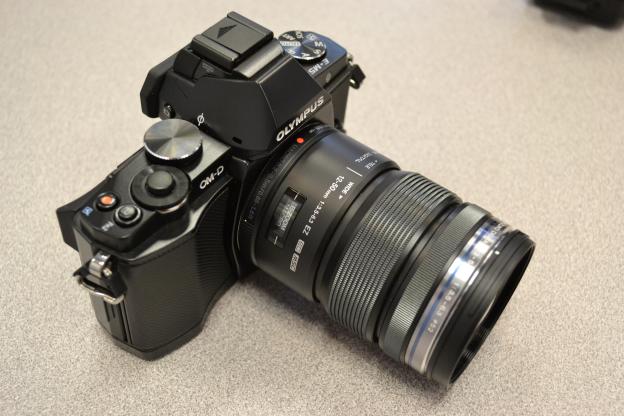 We had the opportunity to briefly go hands-on with the Olympus OM-D E-M5 last month at CES. While we’re anxious to put the real deal to the test, we had a few observations about Olympus’ latest Micro Four Thirds camera. Suffice it to say we’re excited.
We had the opportunity to briefly go hands-on with the Olympus OM-D E-M5 last month at CES. While we’re anxious to put the real deal to the test, we had a few observations about Olympus’ latest Micro Four Thirds camera. Suffice it to say we’re excited.
Size
Probably the most surprising thing about the E-M5 was its size and weight. We have had a lot of experience with the PEN series, particularly the E-P3. The E-P3 was — until now — the most sophisticated of Olympus’ MFT cameras, and upped the ante with a considerable amount of features, as well as a larger, heavier build.
At first sight, the E-M5 just looked bigger, and that can largely be attributed to its EVF. In reality however, the E-M5 is almost exactly the same size as the E-P3. It’s a bit heavier, but again, not overwhelmingly (comparison photo via CameraSize.com).

Of course the battery pack grip changes size altogether, but for those interested in that accessory this is a plus.
We were pretty blown away by how much Olympus packed into a body this size: it increased the sensor’s effective pixel number, added and EVF, and kept the OLED screen, adding a tilt mechanism. We expected this thing to be a lot bigger and bulkier and were happy to see that it’s not. It’s still a true MFT device. Here’s another look at how the two physically line up.

Body
The most striking thing about the E-M5 is, without a doubt, its design. Olympus had an original OM SLR series camera at CES for comparison’s sake, and only with one exception (the Fujifilm X-series) have we seen a new model recreate vintage without looking cheesy.
We don’t need to tell you that the E-M5 is a thing of beauty but we will anyway. The top mounted EVF gives it the class triangular top and it wraps the entire camera with a grip panel, versus the PEN series, which had only front-mounted side grips.
It’s functional yet vintage, and that’s a hard line to toe.

Speed
While the unit we saw at CES was not the finalized thing you’re going to see on the market, it did give us an idea of how the E-M5 will function. One of the major drawbacks of MFT devices is how much slower they are than DSLRs, which automatically makes them a frustration to quite a few photographers. We couldn’t get a good idea of how burst mode in our brief hands-on, but we were able to somewhat test out the AF system. The E-M5 has the same “world’s fastest” moniker Olympus gave its E-P3 and E-PL3, a 35-point high speed AF system. What’s different this time around is that the E-M5 has new 3D tracking integrated into AF so that subject tracking should be improved.
Again we couldn’t entirely put this to the test given conditions, but given our extensive use with the E-P3 and the E-PL3, the E-M5 definitely seemed to have a faster AF. We were also indoors with decent but not great lighting, and experienced no problems — something the new system (coupled with the sensor upgrade) is supposed to improve as well.
EVF
A 100-percent viewfinder makes a world of difference, and a built-in unit is something we’ve been hoping for with the PEN series all along. Of course, we’d more than love to have a hybrid mechanism like the X-series instead of just a small screen mirroring the larger LCD screen, but it’s still a significant upgrade.
The proximity sensor was responsive as well, and the EVF would flip on quickly. No one wants to wait to use the EVF, so this timing was pretty important, and we were happy with it. It also has a nice, sharp resolution, 144k dot, so you get an accurate view.
Its positioning felt more natural than some on other MFT units, which sometimes throw it off to the side. Instead it’s dead center, which gives the camera nice centered weight.
It’s still too early to say how the E-M5 will be received. It’s riding an interesting line between MFT and DSLRs, although critics are sure to cry sensor size quickly. That easy dismissal could hurt it, but we’ll have to wait for our full review to see. Still, it features important improvements from the PEN series, and addresses some old MFT complaints while also taking to task serious competition from Fujifilm and Sony. We’re anxious for a more thorough look at the E-M5.


